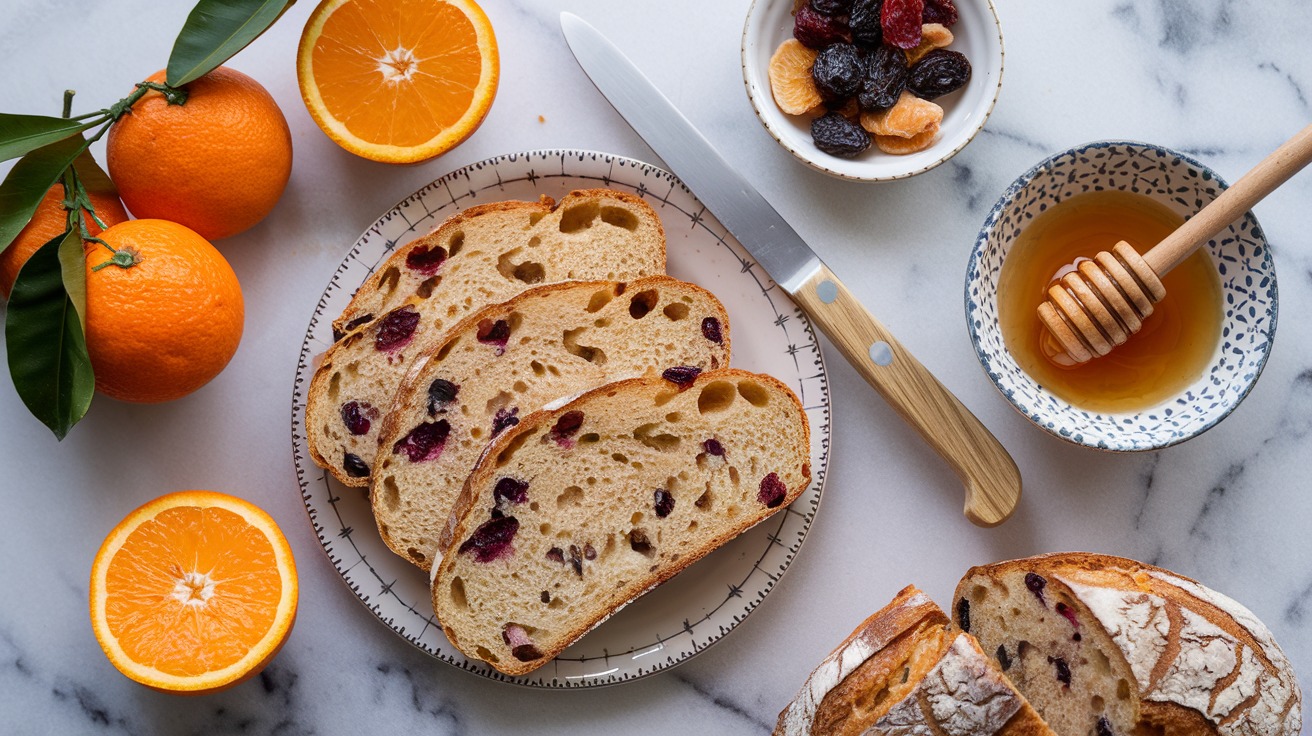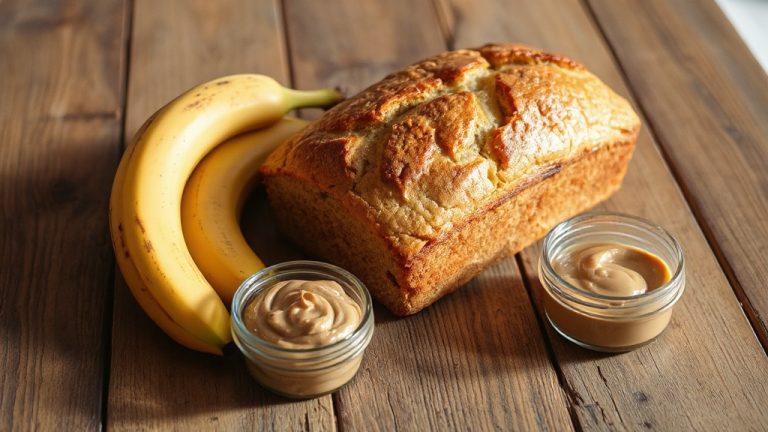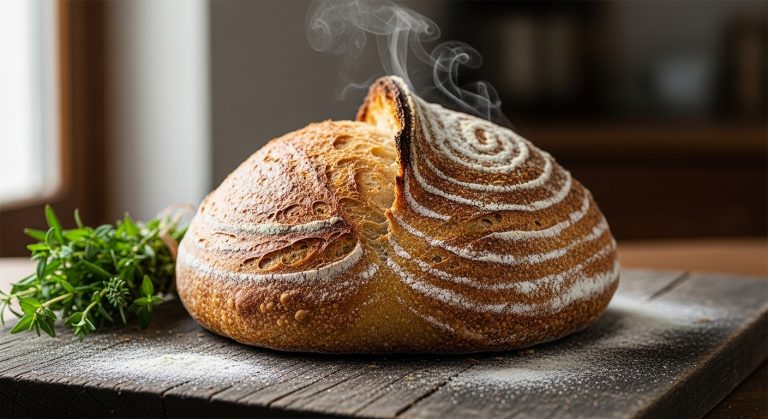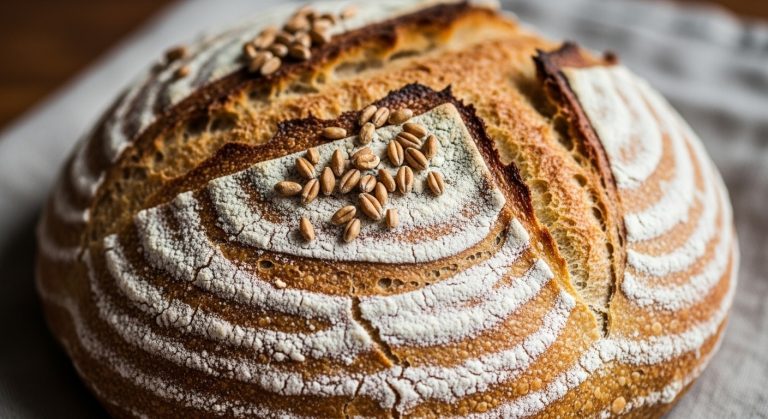Cranberry Orange Sourdough Bread: A Zesty Twist on Classic Bread
Cranberry orange sourdough bread blends the tangy flavor of sourdough with the zesty brightness of fresh orange juice and fragrant zest, punctuated by sweet, chewy cranberries. Begin with an active sourdough starter for ideal fermentation, then mix together strong bread flour, honey, and a splash of orange juice.
Incorporate cranberries before shaping your dough, and after a gentle stretch, fold it to enhance the gluten structure. Bake in a preheated Dutch Oven for a beautifully caramelized crust.
This delightful loaf is more than a treat; it’s a culinary journey waiting to unfold, allowing your taste buds to explore unique flavors and textures.
Key Takeaways
- Use an active sourdough starter and feed it regularly for optimal fermentation and flavor.
- Incorporate dried cranberries and fresh orange juice for a unique flavor profile.
- Employ the stretch and fold technique during bulk fermentation to enhance gluten structure.
- Bake in a preheated Dutch Oven for a crispy crust and airy crumb.
- Store bread properly to maintain freshness and revive flavor by toasting stale slices.
Sourdough Starter Essentials
An active sourdough starter is your best friend in the baking process.
You’ll want to maintain a feeding ratio of 1:3:3 (starter: water: flour) at least 6-8 hours before you plan to bake. A 100% hydration starter—equal parts water and flour by weight—will give you the best dough structure and enhance flavor development.
It is important to regularly check for signs of health, such as bubbling and rising, to confirm that your starter is ready for baking. A healthy starter should also be fed every 1-2 weeks to prevent issues like hooch formation or off odors, which can impact your bread’s flavor and raise regular feeding frequencies.
Look for your starter to be bubbly and have doubled in size at its peak; this is the sweet spot for baking delicious sourdough. A well-maintained starter not only boosts the rise of your dough but also enriches the flavor profile of your bread, enhancing its natural sourness and complexity.
To keep your starter healthy and active, feed it every 1-2 weeks, especially if it’s stored in the refrigerator. Regular attention guarantees it’s ready to work its magic, transforming simple flour and salt into the tangy, aromatic, and utterly delightful sourdough you aim for.
Dough Preparation Steps
To kick off the dough preparation, you’ll blend your active sourdough starter with filtered water, honey, and fresh orange zest in a sturdy bowl.
Next, you’ll fold in strong bread flour and salt until you achieve a shaggy dough that holds promise.
After a brief rest, you’ll master the stretch and fold technique, incorporating those luscious dried cranberries to create a beautifully textured loaf.
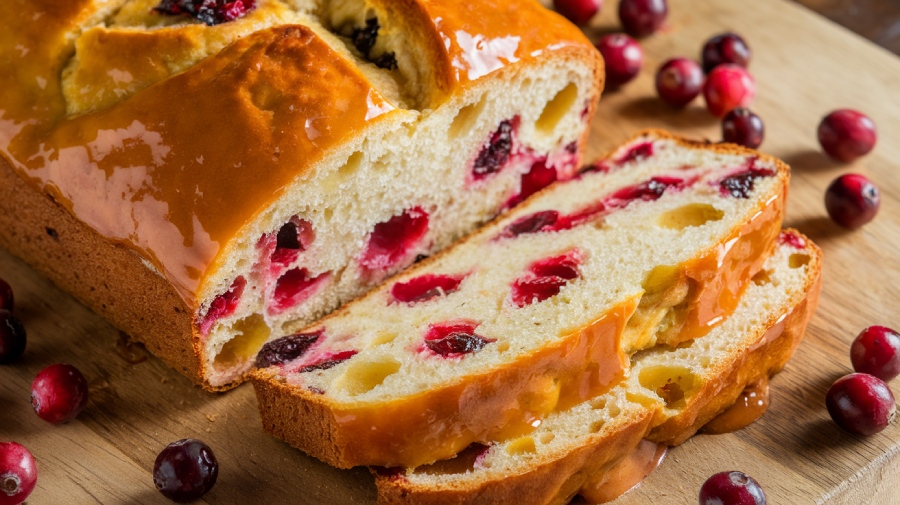
Mixing Ingredients
Creating the perfect dough for your Cranberry Orange Sourdough Bread starts with a harmonious blend of ingredients. Begin by weighing 50g of your active sourdough starter and mixing it with the right amount of water in a ceramic or glass bowl. This base is essential for your dough’s fermentation, as maintaining a consistent feeding schedule for your starter is key to capturing the wild yeast and bacteria needed for peak leavening.
Next, enhance the flavor by adding honey or maple syrup, along with vibrant orange zest and fresh orange juice, creating a fragrant mixture that awakens the senses.
Gradually incorporate strong bread flour and salt into your starter mixture, stirring until you form a shaggy dough. It’s important not to overwork it—just make sure everything’s well combined.
Once your dough comes together, cover it with cling film or a damp tea towel and let it rest for an hour. This rest period promotes hydration and gluten development, setting the stage for a beautiful bread, as proper gluten development is critical for achieving the desired texture.
After resting, shape your dough into a ball with 20-25 gentle stretches. As you prepare for the next steps, know that the cranberries will soon join this delightful blend, enhancing the flavor profile of your bread.
Stretch and Fold
With each gentle stretch and fold, you’re not just working the dough; you’re building its character and strength. This technique is vital for developing the gluten structure that gives your cranberry orange sourdough its lofty rise and delightful texture.
Be certain to utilize a digital scale for precise measurements of your ingredients, as this will enhance the overall quality of your bread. Begin by wetting your hands to prevent sticking, then perform 4-6 sets of stretch and folds over a 2-hour period, allowing 15 minutes of rest between each set. This resting time promotes dough relaxation and enhances the final product.
It’s time to incorporate the dried cranberries into the dough during the second or third stretch and fold. Gently fold them in to guarantee even distribution without overworking the dough, preserving its airy quality.
As you continue, monitor the dough’s hydration and stickiness. If it becomes too wet, don’t hesitate to adjust the flour quantity slightly; finding the right balance is essential for a perfect loaf.
Each stretch and fold infuses air into the dough, enhancing its rise and texture.
Fermentation and Shaping
Allowing your dough to ferment properly is vital for developing the rich flavors and textures that define a great cranberry orange sourdough bread.
Start with bulk fermentation, letting your dough rise until it doubles in size—typically 4-6 hours at room temperature or overnight in the refrigerator. This slow process enhances the flavor and creates a chewy texture, while monitoring the dough rise and performing stretches and folds during fermentation can greatly improve the final result.
After the first fermentation, it’s time to shape the dough. Gently turn it out onto a floured surface and incorporate the cranberries during the stretch and fold process. This guarantees they’re evenly distributed without compromising the dough’s structure.
Shape the dough into a boule or batard by tucking the edges under to create surface tension. This step is vital for achieving a good rise and a beautiful loaf.
Once shaped, place the dough in a banneton, with a smooth side facing down, to encourage an even rise. If you’re opting for cold fermentation, cover the dough loosely and refrigerate it for 5 to 14 hours.
This extra time not only deepens flavors but also enhances the overall baking experience. Your patience will reward you with a loaf that’s bursting with cranberry and orange goodness.
Baking Process
As you preheat your Dutch Oven to a scorching 230°C (450°F), the anticipation builds for that perfect crust.
Scoring the dough just before it meets the heat allows for beautiful, controlled expansion, enhancing both texture and presentation.
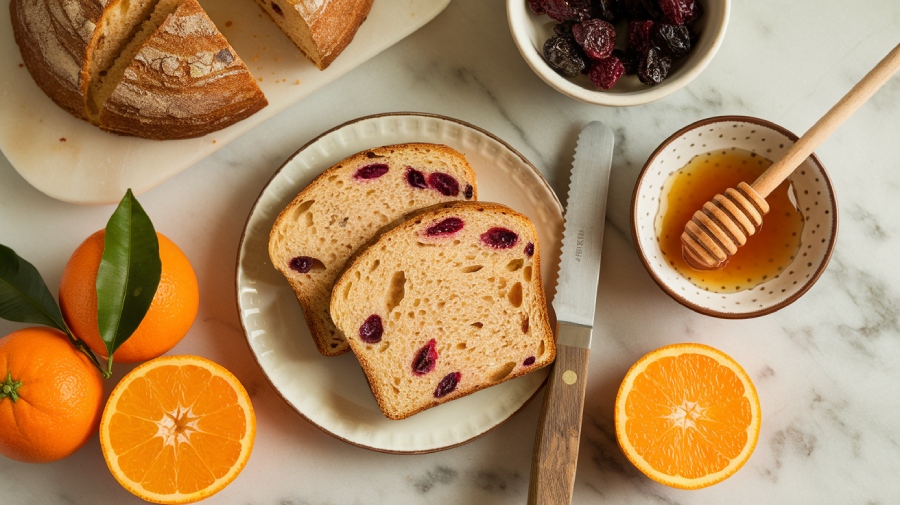
Preheating the Dutch Oven
Preheating the Dutch Oven to a scorching 230°C (450°F) for at least one hour is essential for achieving that perfect sourdough loaf. This step isn’t just routine; it’s crucial for creating a hot surface that promotes an impressive oven spring.
Steam’s role in maintaining a moist environment enhances both flavor and texture, ensuring your bread rises beautifully as it bakes, resulting in a light, airy crumb.
During the preheating process, the Dutch Oven traps steam, which contributes to a beautifully crispy crust. This steam is your secret weapon for that coveted texture, transforming your loaf into a rustic masterpiece.
To avoid any mishaps, place a baking sheet beneath the Dutch Oven to catch any drips and prevent burning the base.
As you prepare to place your dough inside, remember that a properly preheated Dutch Oven can greatly enhance the overall texture and appearance of your finished loaf.
Scoring Technique
With the Dutch Oven ready to create that perfect baking environment, it’s time to focus on scoring your dough, a technique that plays a vital role in the final outcome of your sourdough loaf.
Scoring involves making shallow cuts on the surface, allowing the bread to expand properly in the oven while maintaining a uniform shape. This technique not only facilitates steam release but also influences the rise and crust quality of your bread, showcasing your baking skills.
To achieve clean cuts, grab a sharp blade, like a lame or a razor. This precision prevents deflation and guarantees the dough rises beautifully. Aim for a scoring depth of about ¼ inch; this simple guideline can greatly influence your loaf’s oven spring and texture.
Let your creativity flow with scoring patterns! From straight lines to intricate designs, how you score can elevate the visual appeal of your finished bread.
Just remember, timing is essential. Score your dough right before it goes into the preheated oven. This timing captures the initial steam, enhancing the rise and crust development, which is key for achieving a beautifully risen loaf with an appealing crust.
Baking Temperature Adjustments
Achieving the perfect crust on your cranberry orange sourdough bread hinges on precise baking temperature adjustments. Start by preheating your oven to a blistering 230°C (450°F) with the Dutch Oven inside for at least an hour. This guarantees the heat retention you need for that vital first phase of baking.
When your dough is ready to bake, place it in the hot Dutch Oven and cover it for the first 30 minutes. This covered baking traps steam, promoting an impressive oven spring and enhancing crust development.
After that initial burst of activity, uncover the Dutch Oven and lower the oven temperature to 210°C (410°F). This adjustment allows the crust to caramelize beautifully, giving your bread that enticing golden hue.
Keep an eye on the internal temperature; it should reach between 190°F to 205°F (87°C to 96°C) to confirm it’s fully baked. Every oven is unique, so you might need to tweak the baking times based on your specific appliance.
Storage Tips
How can you keep your cranberry orange sourdough bread fresh and delicious for as long as possible? Start by storing it cut side down on a cutting board for up to 3-4 days. This simple storage tip helps maintain peak freshness while preventing the bread from drying out.
If you want to preserve it longer, slice the bread and place it in a freezer-safe bag. It can stay in the freezer for up to 2 weeks without losing quality.
When you’re ready to enjoy your frozen loaf, don’t fret! You can pop it directly from the freezer into the toaster, making it an easy and quick option for breakfast or snacks.
To retain moisture and flavor, make sure the bread cools completely before slicing—cutting too soon can lead to a gummy texture that detracts from its charm.
If you notice your bread starting to stale, toasting it can revive its flavor and texture, making each bite a delightful experience.
Troubleshooting Guide
Baking cranberry orange sourdough bread can be a delightful experience, but sometimes things don’t go as planned. If your bread doesn’t rise sufficiently, verify your active starter is at its peak. This typically occurs 6-8 hours after feeding. If the dough has rested but remains dense, you may not have allowed enough bulk fermentation time; the dough should double in size and feel jiggly.
Here’s a quick troubleshooting guide to help you:
| Issue | Possible Cause | Solution |
|---|---|---|
| Dough is too wet | Excess moisture or flour ratio | Add flour incrementally during kneading |
| Bread is too dense | Insufficient bulk fermentation time | Verify it doubles in size before baking |
| Popping cranberries | Uneven distribution in the dough | Gently poke them back in during shaping |
If the crust turns out too hard, consider lowering the baking temperature and check that the internal temperature reaches 190-205°F (87-96°C).
Frequently Asked Questions
Can I Add Orange Juice to Sourdough?
Absolutely, you can add orange juice to your sourdough!
In fact, incorporating citrus can enhance the flavor profile considerably—up to 30% of bakers report improved taste experiences. Just replace some water with fresh orange juice to keep your dough’s hydration balanced.
Don’t forget to include orange zest for that vibrant aroma. The acidity boosts fermentation, so your bread might rise even better.
Just monitor the sugar content to guarantee a successful bake!
How to Add Dried Cranberries to Sourdough?
To add dried cranberries to your sourdough, start by soaking them in orange juice for about 30 minutes. This step enhances their flavor and juiciness.
During your second or third stretch and fold, gently incorporate the cranberries into the dough, making sure to avoid breaking them apart.
Keep an eye on the dough’s hydration; you might need to adjust the flour to maintain the right consistency.
Enjoy the delightful texture and flavor they bring!
Why Is Sourdough the Healthiest?
Did you know that sourdough bread can have up to 50% more bioavailable nutrients than conventional bread?
When you choose sourdough, you’re not just enjoying a delicious loaf; you’re also benefiting from improved digestion and gut health. The fermentation process breaks down gluten, making it easier on your system.
Plus, the lower glycemic index helps stabilize your blood sugar. With each bite, you’re nurturing your body while savoring rich, complex flavors.
What Makes San Francisco Sourdough Bread so Good?
San Francisco sourdough bread stands out for its unique tangy flavor, thanks to the region’s wild yeast and Lactobacillus bacteria.
You’ll love the moist crumb and chewy crust that come from using a 100% hydration starter. The long fermentation, often lasting 12-24 hours, deepens the flavor and enhances digestibility.
Plus, when it’s baked in a steam-filled oven, that iconic crust gets perfectly caramelized, creating a truly unforgettable experience with each bite.
A Loaf to Remember: The Sweet and Tangy Journey of Cranberry Orange Sourdough
So there you have it—your cranberry orange sourdough bread journey! With your starter bubbling like it’s got a secret, you’ve danced through dough prep, fermentation, and the glorious moment of baking.
If it flops, just remember: even Picasso had his off days. So, slice that bread, slather on the butter, and revel in your culinary masterpiece (or happy accident). After all, in the world of baking, every loaf tells a story—yours just might be a comedy!

